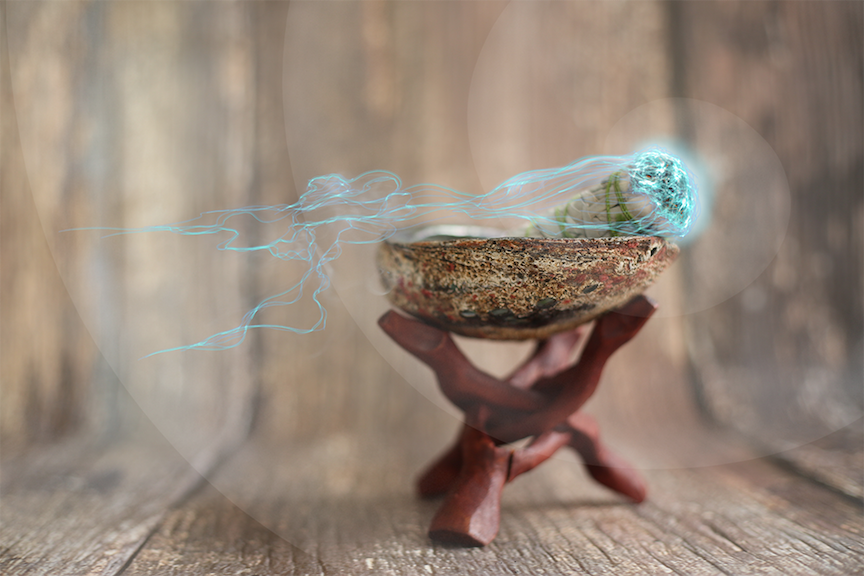
Last month Kelly Burch, a writer for HealthyWay Media, reached out to see if I would contribute to a piece on the practice of sage cleansing—also known as smudging. It was a great opportunity to link Iphelia’s message of feeling our feelings and tending to our inner lives with awareness to a timely and trending topic. I was in!
A Brief History of Sage
Throughout human history, most traditions have had some kind of smoke cleansing or blessing ritual. In the traditions of the East, various herbs are burned in the form of incense. In the West, we have things like frankincense and myrrh. Regardless of the tradition, every culture embodies an element of something being reduced to ash as the smoke travels up toward the heavens. Even people who aren’t familiar with or fond of burning incense might light candles to create a feeling of relaxation or reverence in a space. I believe we all have a relationship with burning and rising smoke that is deeply rooted in our psyche as a symbol of cleansing and transmutation. It easily evokes feelings of surrender and renewal.
My History With Sage
I was first exposed to sage smudging during my training at the Wellness Institute in Issaquah, Washington. Our teachers there would not only used sage during ritual events like the Inipi ceremony, but also after any intense therapeutic group work we had done. The Wellness Institute would regularly invite local indigenous people from different local tribes to facilitate ceremonies.
Our Lakota guests would encourage us in the work we were doing as therapists, describing it in their terms as “washing off the old man.” I also went on to participate in Vision Quest ceremonies facilitated by indigenous people (Lakota, Cherokee and Havasupai) in Sedona, Arizona. During the Vision Quest, large amounts of sage would be burning for days to protect the questers. When I first arrived in the desert I was stunned at the sight of a large curbside-style trash can filled to the brim with white sage!
At first, after doing intense cathartic work, I only felt tolerant of my teachers’ need to waft smoke around me. Like the time during a hypnotherapy session when I had beat the holy living shit out of a punching bag and then cried my eyes out over the loss of walking with that hurt and anger for so long: smudging was something they felt needed to be done, and though I didn’t find the smell particularly fragrant, I appreciated their care. In time I grew to really value and look forward to being smudged. I was already acquainted with the experience of using incense or frankincense to calm and cleanse the mind from my explorations of various spiritual centers around St. Louis and my time in India. But sage was different than the other substances. It smelled earthy and felt more grounding than the other stuff. And coupled with my exposure to the teachings of the indigenous leaders, sage instilled in me a more conscious and personal relationship with Mother Earth.
Using Sage in My Practice
Today, the Personal Transformation Intensive (PTI) program I lead with my co-teacher Barbara Magallanes incorporates rituals and teachings from various wisdom traditions that we synthesize with practical psychological principles. We include a lot of Indigenous American rituals, practices, and teachings including omen identification, understanding cycles of experience via the concept of the medicine wheel, drumming, and smudging—all of which encourage conscious and intentional relationships with all living things and the earth.
As I told Kelly, we use sage specifically to help our students transition from intense and energetic releases of trauma back into calmer states of awareness that allow for continued participation in the group’s work. We use a diversity of healing modalities like hypnotherapy, conscious connected breathing, kundalini meditation, and music and art therapy to address trauma, addiction, depression, anxiety, and even disease. We create an extremely safe and simultaneously challenging environment that supports the students in fully addressing whatever internal blockages bubble up for them. When a student releases strong feelings of anger or shame or grief, we want to make sure they don’t stay stuck in that experience or get pulled back into it, so we use sage to cleanse their field. Ultimately, smudging supports the individual student and the group in transitioning into a stronger more grounded state of consciousness.

In addition to transitioning from one feeling-state to another, we want to try to conjure some inspired feeling while cleansing, which is usually pretty easy to do once the group has witnessed someone do their hard work. When people drop in and feel what is really going on for themselves in whatever challenge they are facing, everyone in the group is affected in a way that opens their heart. When someone faces their fear, there’s the sense of having witnessed something really miraculous. It’s like an Oprah moment on steroids—so it’s usually pretty easy to feel inspired while we smudge.
What Sage Cleansing Looks Like
Imagine a friend or family member reclined comfortably on a yoga mat with their eyes closed. During their practice they become very present and achieve a feeling of peace and connection they haven’t felt since early childhood. Then suddenly and without any apparent precipitating event, that reclaimed peak is interrupted by feelings of anger, shame, or sorrow. Oftentimes when we reach a new peak of emotional experience, old unfinished feelings from our childhoods that oppose the good feelings rise to the surface seeking an opportunity for completion.
Our imagined friend then spontaneously regresses to a traumatic memory and if that repressed emotional energy is allowed to complete its cycle, they may realize a truth about their experience that they’ve never been able to see until this moment. They may cry, scream into a pillow, or even hit the pillow a couple of times. The energy moves and a powerful shift occurs throughout the nervous system, giving them a feeling of release that returns them to a more whole and integrated state of consciousness. They may feel more empowered. They may have found some much-needed humility. They may resolve to finally set a boundary or make long overdue amends. They may finally let go and grieve and say goodbye.
In any case, they see more clearly the relationship between the past trauma and ways they’ve been thinking, feeling, and living in the present. Their cheeks may be tear streaked, but you can see a sense of calm has washed over them. They know something new, about their self and their world, and they seem more grounded, more in touch with themselves and who they really are than they were even an hour ago. After all that catharsis there is obvious relief but they still feel something residual sticking around that they clearly want gone (fear, shame, anger, blame, etc).
This is an example of when we might use sage cleansing. There are a bunch of different ceremonies and ritualistic ways to use smudging, but our method is basically to use a feather wand and just wave the burning sage all around the person’s body as if we’re dusting them off with the smoke. As I told Kelly, this practice changes the atmosphere around the person who’s just done their work and those who’ve witnessed and supported it. The air smells, looks, and feels different—signaling to everyone the change that occurred, not just mentally or emotionally, but also physically.
How I Recommend My Students Use Sage
This same grounding through atmospheric change can be achieved when we use sage in our living spaces, offices, or a yoga studio, for example. That said, there are a lot of other options for clearing residual energy out of your system. You can use incense instead of sage. Various energetic healing modalities (reiki, pranic healing, subtle energy training, etc.) teach clearing techniques that involve specific patterns of breathing, movement, and visualization.
Chanting or playing music in a space can transmute subtle energies as well. You’ll just want to be sure and consider the quality of whatever music you are using to cleanse your space with. And one of the simplest and most obvious ways to clear your own system is to take a shower. But always what is important is to be intentional and breathe and feel. Using attention and focus to allow yourself to see and feel things shifting as you perform your ritual is what really does the trick.
For more on sage cleansing including insights from Donna Henes, Caleb Backe at Maple Holistics, Charlotte McFarlin of Magic Mamma Movement, and Lori Knowles at Soul Path Advancement, check out Kelly’s article on HealthyWay.

